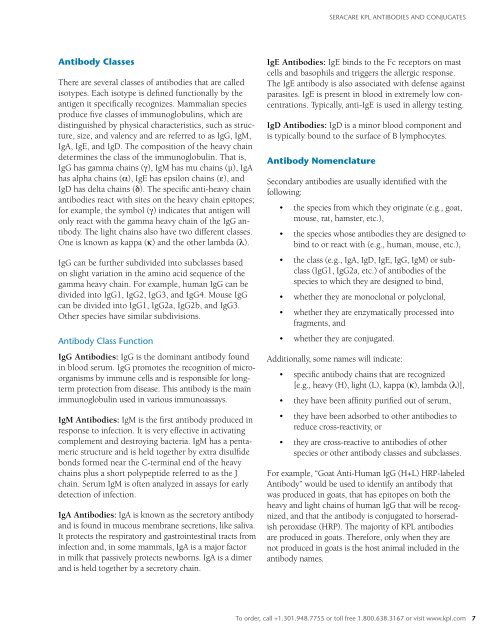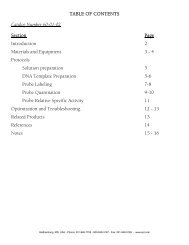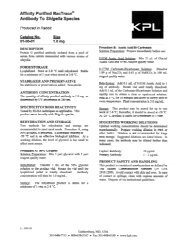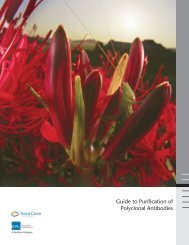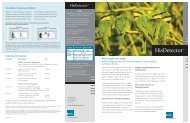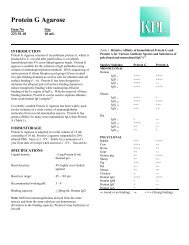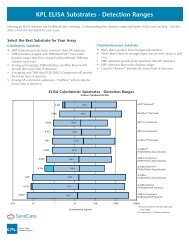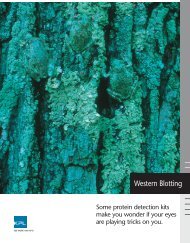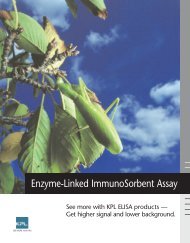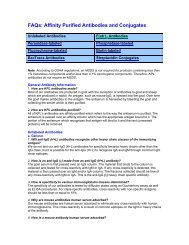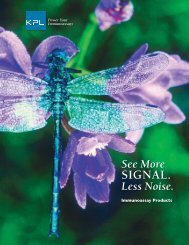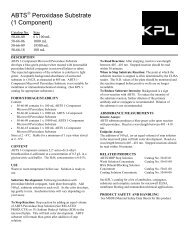KPL Antibodies and Conjugates Catalog
KPL Antibodies and Conjugates Catalog
KPL Antibodies and Conjugates Catalog
You also want an ePaper? Increase the reach of your titles
YUMPU automatically turns print PDFs into web optimized ePapers that Google loves.
SERACARE <strong>KPL</strong> ANTIBODIES AND CONJUGATESAntibody ClassesThere are several classes of antibodies that are calledisotypes. Each isotype is defined functionally by theantigen it specifically recognizes. Mammalian speciesproduce five classes of immunoglobulins, which aredistinguished by physical characteristics, such as structure,size, <strong>and</strong> valency <strong>and</strong> are referred to as IgG, IgM,IgA, IgE, <strong>and</strong> IgD. The composition of the heavy chaindetermines the class of the immunoglobulin. That is,IgG has gamma chains (γ), IgM has mu chains (μ), IgAhas alpha chains (α), IgE has epsilon chains (ε), <strong>and</strong>IgD has delta chains (δ). The specific anti-heavy chainantibodies react with sites on the heavy chain epitopes;for example, the symbol (γ) indicates that antigen willonly react with the gamma heavy chain of the IgG antibody.The light chains also have two different classes.One is known as kappa (κ) <strong>and</strong> the other lambda (λ).IgG can be further subdivided into subclasses basedon slight variation in the amino acid sequence of thegamma heavy chain. For example, human IgG can bedivided into IgG1, IgG2, IgG3, <strong>and</strong> IgG4. Mouse IgGcan be divided into IgG1, IgG2a, IgG2b, <strong>and</strong> IgG3.Other species have similar subdivisions.Antibody Class FunctionIgG <strong>Antibodies</strong>: IgG is the dominant antibody foundin blood serum. IgG promotes the recognition of microorganismsby immune cells <strong>and</strong> is responsible for longtermprotection from disease. This antibody is the mainimmunoglobulin used in various immunoassays.IgM <strong>Antibodies</strong>: IgM is the first antibody produced inresponse to infection. It is very effective in activatingcomplement <strong>and</strong> destroying bacteria. IgM has a pentamericstructure <strong>and</strong> is held together by extra disulfidebonds formed near the C-terminal end of the heavychains plus a short polypeptide referred to as the Jchain. Serum IgM is often analyzed in assays for earlydetection of infection.IgA <strong>Antibodies</strong>: IgA is known as the secretory antibody<strong>and</strong> is found in mucous membrane secretions, like saliva.It protects the respiratory <strong>and</strong> gastrointestinal tracts frominfection <strong>and</strong>, in some mammals, IgA is a major factorin milk that passively protects newborns. IgA is a dimer<strong>and</strong> is held together by a secretory chain.IgE <strong>Antibodies</strong>: IgE binds to the Fc receptors on mastcells <strong>and</strong> basophils <strong>and</strong> triggers the allergic response.The IgE antibody is also associated with defense againstparasites. IgE is present in blood in extremely low concentrations.Typically, anti-IgE is used in allergy testing.IgD <strong>Antibodies</strong>: IgD is a minor blood component <strong>and</strong>is typically bound to the surface of B lymphocytes.Antibody NomenclatureSecondary antibodies are usually identified with thefollowing:• the species from which they originate (e.g., goat,mouse, rat, hamster, etc.),• the species whose antibodies they are designed tobind to or react with (e.g., human, mouse, etc.),• the class (e.g., IgA, IgD, IgE, IgG, IgM) or subclass(IgG1, IgG2a, etc.) of antibodies of thespecies to which they are designed to bind,• whether they are monoclonal or polyclonal,• whether they are enzymatically processed intofragments, <strong>and</strong>• whether they are conjugated.Additionally, some names will indicate:• specific antibody chains that are recognized[e.g., heavy (H), light (L), kappa (κ), lambda (λ)],• they have been affinity purified out of serum,• they have been adsorbed to other antibodies toreduce cross-reactivity, or• they are cross-reactive to antibodies of otherspecies or other antibody classes <strong>and</strong> subclasses.For example, “Goat Anti-Human IgG (H+L) HRP-labeledAntibody” would be used to identify an antibody thatwas produced in goats, that has epitopes on both theheavy <strong>and</strong> light chains of human IgG that will be recognized,<strong>and</strong> that the antibody is conjugated to horseradishperoxidase (HRP). The majority of <strong>KPL</strong> antibodiesare produced in goats. Therefore, only when they arenot produced in goats is the host animal included in theantibody names.To order, call +1.301.948.7755 or toll free 1.800.638.3167 or visit www.kpl.com7


